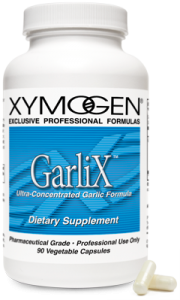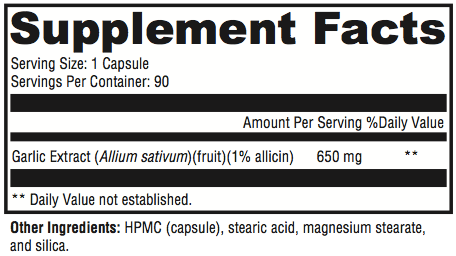GarliX
 Well known as a venerated culinary herb, garlic (Allium sativum) has been used for centuries to support health and longevity. It has been found in Egyptian pyramids, ancient Greek temples, medical texts from a variety of cultures, and even on Hippocrates’ list of health-promoting compounds.[1] Garlic is used widely today to support cardiovascular health, antioxidant activity, and immune function.*[2,3]Organosulfur Compounds and Antioxidant Activity Many of the health-promoting benefits of garlic are attributed to its array of sulfur-containing compounds. Organosulfur compounds from whole garlic fall into two classes: gamma- glutamylcysteines and cysteine sulfoxides.[4] Crushing, chopping, and processing garlic results in production of organosulfur compounds that fall into one of four main chemical classes—alliin, allicin, allyl cysteine, and allyl disulfide. Several of these compounds have been studied for their compelling effect on antioxidant activity. Alliin (allylcysteine sulfoxide) was found to scavenge superoxide, while allicin (a thiosulfinate) suppressed its formation. Hydroxyl radicals were scavenged by alliin, allyl cysteine, and allyl disulfide; allyl disulfide was found to be a lipid peroxidation terminator as well.[5] GarliX contains standardized amounts of gamma-glutamylcysteines, alliin, allicin, thiosulfinates, and sulfur.*
Well known as a venerated culinary herb, garlic (Allium sativum) has been used for centuries to support health and longevity. It has been found in Egyptian pyramids, ancient Greek temples, medical texts from a variety of cultures, and even on Hippocrates’ list of health-promoting compounds.[1] Garlic is used widely today to support cardiovascular health, antioxidant activity, and immune function.*[2,3]Organosulfur Compounds and Antioxidant Activity Many of the health-promoting benefits of garlic are attributed to its array of sulfur-containing compounds. Organosulfur compounds from whole garlic fall into two classes: gamma- glutamylcysteines and cysteine sulfoxides.[4] Crushing, chopping, and processing garlic results in production of organosulfur compounds that fall into one of four main chemical classes—alliin, allicin, allyl cysteine, and allyl disulfide. Several of these compounds have been studied for their compelling effect on antioxidant activity. Alliin (allylcysteine sulfoxide) was found to scavenge superoxide, while allicin (a thiosulfinate) suppressed its formation. Hydroxyl radicals were scavenged by alliin, allyl cysteine, and allyl disulfide; allyl disulfide was found to be a lipid peroxidation terminator as well.[5] GarliX contains standardized amounts of gamma-glutamylcysteines, alliin, allicin, thiosulfinates, and sulfur.*
Glutathione (gamma-glutamyl-cysteinyl-glycine) is a well-researched component of vital antioxidant systems in the body. Glutathione is also recognized for its role in regulation of cellular events such as DNA and protein synthesis, gene expression, cell-life cycle regulation, signal transduction, cytokine production, and immune response.[6] Gamma-glutamylcysteine (GGC), an endogenously produced precursor to glutathione, has been found to efficiently detoxify hydrogen peroxide and superoxide anion in the mitochondria. Research suggests that GGC may assume the neuroprotective and antioxidant functions of glutathione as needed.*[7]
Cardiovascular Health Numerous studies suggest that garlic has a positive effect on plasma lipids, normal fibrinolytic and platelet activity, and the maintenance of blood pressure and blood glucose already within the normal range.[8] A meta- analysis of 26 studies showed that garlic supported total cholesterol and triglyceride metabolism with a significance of p = 0.001 and p < 0.001 respectively.[9] Studies suggest that garlic may play a cardioprotective role in maintaining normal levels of oxidized low-density lipoprotein (LDL), nitric oxide production, healthy cytokine balance, and normal endothelial function as well.[10,11] Garlic-derived organosulfur compounds are converted by erythrocytes into hydrogen sulfide, which in turn supports vasodilation, vascular smooth muscle relaxation, and overall cardiovascular health.[12] Garlic supplementation had a significant impact on cardiovascular health parameters in select subjects during a 12-week, randomized, single-blind placebo-controlled study.*[13]
Immune Support In the mid-1900s, Louis Pasteur noted garlic’s ability to support immune function, and it is known to have been used for immune support during World War I.[12] Ongoing research reveals a broad range of immune-supportive properties associated with garlic, especially its allicin component.[4,14] Allicin appears to react with the thiol groups of a variety of enzymes (including alcohol dehydrogenase, thioredoxin reductase, and RNA polymerase), which, in turn, supports normal microbial balance in the body.[15] A double-blind placebo-controlled study of 146 volunteers suggests that stabilized allicin compound is significantly effective in supporting and maintaining healthy immune function.*[16]
Modern-day research appears to confirm the health-promoting properties of garlic that ancient Egyptians, Greeks, Chinese, and Indian cultures embraced for so long. GarliX is an ultra-concentrated garlic formula with standardized levels of several organosulfur compounds designed to support antioxidant, cardiovascular, and immune systems.*
Directions
as
References
- Rivlin RS. Historical perspective on the use of garlic. J Nutr. 2001 Mar;131(3s):951S-4S. [PMID: 11238795]
- Natural Standard Garlic Monograph. http://naturalstandard.com/databases/herbssupplements/garlic.asp. Accessed April 17, 2012.
- Krinsky DL, LaValle JB, Hawkins EB, et al. Natural Therapeutics Pocket Guide. 2nd ed. Hudson (OH): Lexi-Comp; 2003.
- Linus Pauling Institute. http://lpi.oregonstate.edu/infocenter/phytochemicals/garlic/. Accessed April 18, 2012.
- Chung LY. The antioxidant properties of garlic compounds: allyl cysteine, alliin, allicin, and allyl disulfide. J Med Food. 2006 Summer;9(2):205-13. [PMID: 16822206]
- Wu G, Fang YZ, Yang S, et al. Glutathione metabolism and its implications for health. J Nutr. 2004 Mar;134(3):489-92. [PMID: 14988435]
- Quintana-Cabrera R, Fernandez-Fernandez S, Bobo-Jimenez V, et al. Γ-glutamylcysteine detoxifies reactive oxygen species by acting as glutathione peroxidase-1 cofactor. Nat Commun. 2012 Mar 6;3:718. [PMID: 22395609]
- Rahman K. Historical perspective on garlic and cardiovascular disease. J Nutr. 2001 Mar;131(3s):977S-9S. Review. [PMID: 11238800]
- Zeng T, Guo FF, Zhang CL, et al. A meta-analysis of randomized, double-blind, placebo-controlled trials for the effects of garlic on serum lipid profiles. J Sci Food Agric. 2012 Jan 10. [Epub ahead of print] [PMID: 22234974]
- Gorinstein S, Jastrzebski Z, Namiesnik J, et al. The atherosclerotic heart disease and protecting properties of garlic: contemporary data. Mol Nutr Food Res. 2007 Nov;51(11):1365-81. Review. [PMID: 17966138]
- Siegal G, Malmsten M, Pietzsch J, et al. The effect of garlic on arteriosclerotic nanoplaque formation and size. Phytomedicine. 2004 Jan;11(1):24-35. [PMID: 14971718]
- Ginter E, Simko V. Garlic (Allium sativum L.) and cardiovascular diseases. Bratisl Lek Listy. 2010;111(8):452-6. Review. [PMID: 21033626]
- Ashraf R, Aamir K, Shaikh AR, et al. Effects of garlic on dyslipidemia in patients with type 2 diabetes mellitus. J Ayub Med Coll Abbottabad. 2005 Jul-Sep;17(3):60-4. [PMID: 16320801]
- Harris JC, Cottrell SL, Plummer S, et al. Antimicrobial properties of Allium sativum (garlic). Appl Microbiol Biotechnol. 2001 Oct;57(3):282- 6. Review. [PMID: 11759674]
- Ankri S, Mirelman D. Antimicrobial properties of allicin from garlic. Microbes Infect. 1999 Feb;1(2):125-9. Review. [PMID: 10594976]
- Josling P. Preventing the common cold with a garlic supplement: a double-blind, placebo-controlled survey. Adv Ther. 2001 Jul- Aug;18(4):189-93. [PMID: 11697022]








